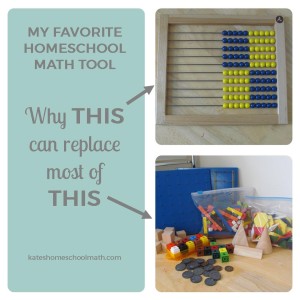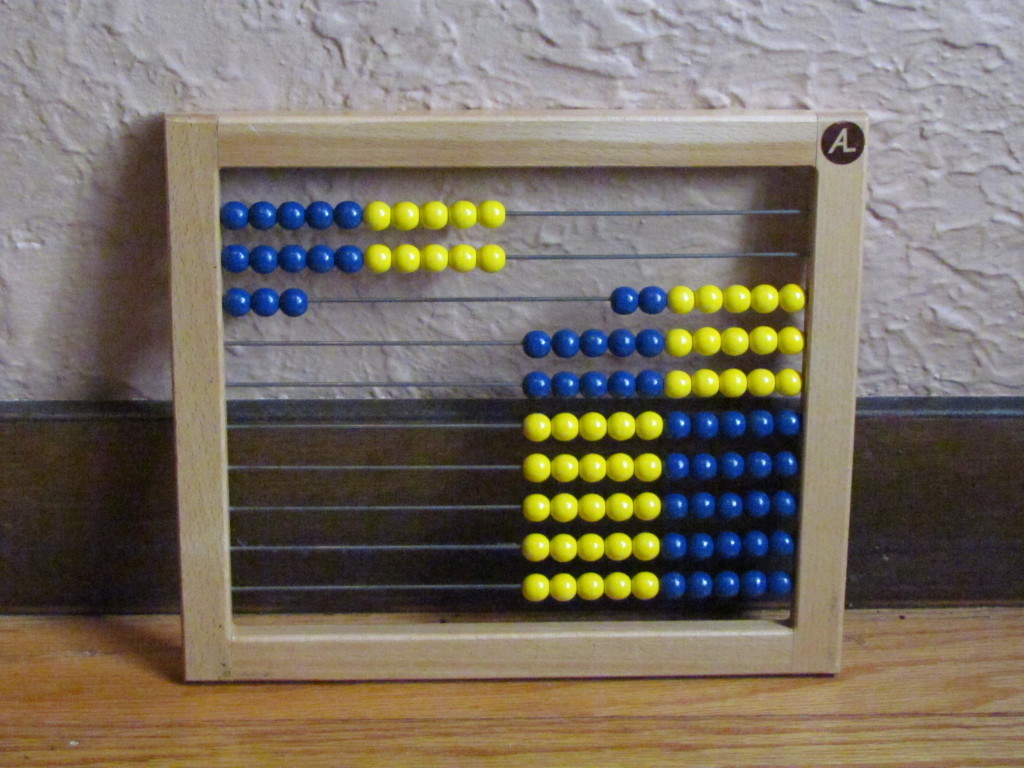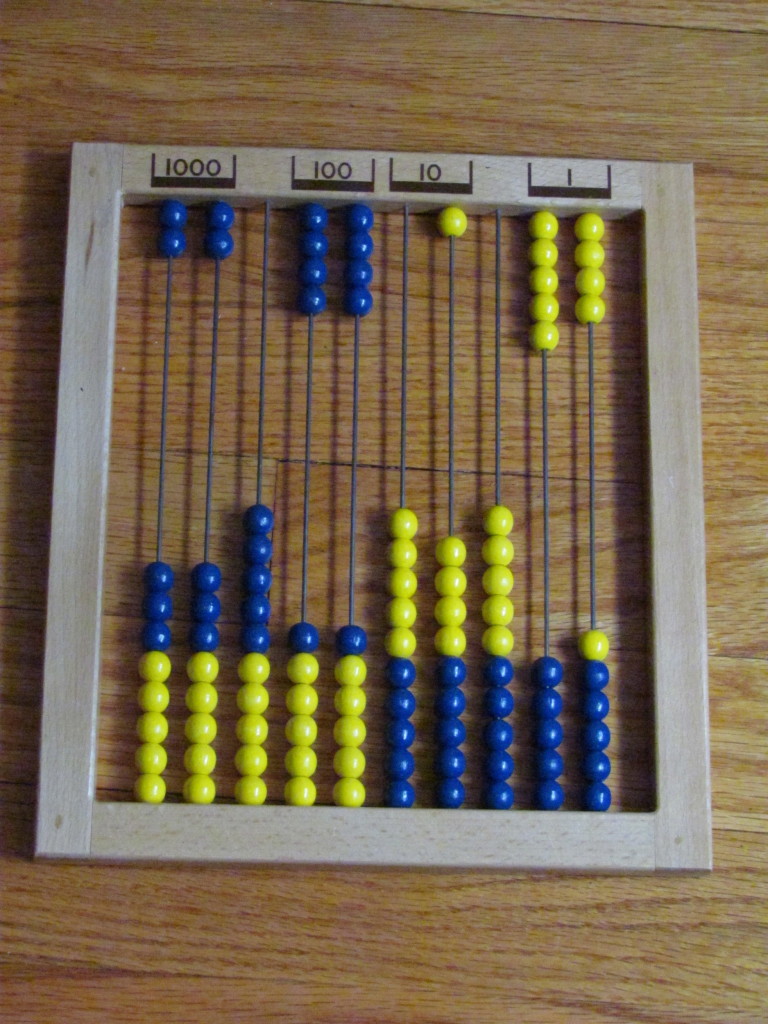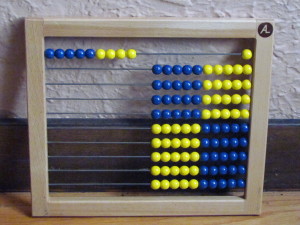 Manipulatives are a great tool for teaching homeschool math, especially when your goal is helping your child understand math. I’ve developed quite a collection over the years, but there’s only one manipulative that gets used daily in my homeschool: the AL Abacus.
Manipulatives are a great tool for teaching homeschool math, especially when your goal is helping your child understand math. I’ve developed quite a collection over the years, but there’s only one manipulative that gets used daily in my homeschool: the AL Abacus.
What is the AL Abacus?
The abacus is deceptively simple. It’s just ten rows of ten beads each, with alternating colors to emphasize groups of five. To enter a number on the abacus, you just slide over the correct number of beads.

When you flip it to the back, the wires are labeled 1000, 100, 10, and 1 so that you can use it to represent 4-digit numbers.

Why the AL Abacus is my favorite manipulative
1. It encourages kids to think of numbers as groups. Every time you enter a number on the abacus, it shows you that number in relation to other numbers. For example, if you enter nine on the abacus, the contrast between the blue and yellow beads immediately shows you that nine is four more than five. Plus, the one yellow bead remaining on the right side of the wire shows that nine is one less than 10. This helps kids internalize number relationships much more quickly than when they’re only counting out piles of counters.

2. It’s versatile. You can use it to teach pretty much everything through third-grade math:
- Addition and subtraction fact strategies
- Multi-digit addition and subtraction
- Place-value
- Single-digit multiplication
For example, here’s how to use the abacus to show a helpful addition fact strategy. This abacus shows 9 + 6. You can “trade” one bead by removing it from the 6-wire and adding it to the 9-wire. Then, it’s easy to see that 9 + 6 is really 10 + 5, or 15.

3. It helps you use your math time efficiently. This example of 9 + 6 might seem familiar, since we used a similar strategy with ten-frames. I love ten-frames and other manipulatives, but it takes a lot of time to lay out all the counters and then collect them up again. With the abacus, a quick swipe of the finger enters the correct number of beads. You can do a lot more math in a lot less time.
An abacus isn’t necessary for teaching homeschool math, but I sure find it helpful. You can use it along with any curriculum to make your math time more effective. As my kids have used the abacus more and more, they’ve developed an “abacus in their heads” that gives them terrific number sense and mental math skills. Even my four-year-old is starting to be able to use her “mental abacus” to solve problems. (The other day, she was able to figure out that 50 is half of 100, just by imagining the abacus and thinking about the groups of 10!) If you buy one math manipulative for your younger math student this year, the AL Abacus is the one to get.
Buy your own abacus directly from RightStart here.
Happy Math!




I’m so glad I found your website! 🙂 We mainly use multi-link cubes, but I have a toddler that likes to put things in her mouth, so this would be a great alternative!
Janine, I never thought of that before as a benefit of the abacus, but you’re totally right! And the abacus can’t spill either. 🙂
The abacus on Amazon has several negative reviews saying that it’s flimsy and doesn’t stand on its own. Do you have an alternative suggestion, or do you still think it’s worth it?
Hi Maria, I haven’t directly compared the version that RightStart sells with the version that Amazon sells, so I don’t know about the quality of the plastic. My guess is that people are comparing it to the Melissa and Doug-type wooden abacuses. Those look sturdier, but the groups of 5 on this abacus make it far superior since they allow kids to visually see the groups of 6, 7, 8, and 9 without having to count each bead one-by-one. My abacus, which I bought years ago from RightStart, has held up fine to a lot of use.
Dr. Cotter (the author of RightStart) actually meant for this abacus to be used flat on the table, so that reviewer just wasn’t understanding how to use it. I went in to Amazon and left a comment to that effect, so hopefully she’ll be able to lay down her abacus-holding responsibilities soon!
I can’t imagine life without our abacus. It’s an invaluable tool. Thank you so much for your Math Blog. We love math and I am often here reading your articles over and over again. I have a struggling math learner and an accelerated math learner so I am constantly trying to balance myself between the two children. One manipulative that is a constant in our home is that abacus. We love RS Activities for the AL abacus book (and corresponding workbook) and we love Cotter’s Card Games book/games, too. I use Math U see for one child and Math Mammoth for my other child. We are currently waiting for Beast Academy to come out with the rest of Level 2. Have a great day!
I did a hack on our Melissa and Doug abacus to replicate this (it has the added bonus of letting you use different colors for place values). I have a question about that flip side (place value) – are there some ground rules or something about how you approach it? Is the idea that you use both ones columns, but only use the top five beads? Even with that, what about that tenth bead? In the world of the soroban there is no way to have 10 without using a ten bead, and that makes perfect sense to me. But we like to use a couple of different manipulatives to solidify concepts, so I’d like to get my mind clear about this one.
Hi Michael,
On the flip side, RightStart uses 2 wires per place value and encourages kids to move the beads in pairs up the wires. So, for example to put 7 in the ones-place, you move up 3 pairs of beads plus one more bead.
The main benefit of having 20 beads available in each place value is that you can see the trades made when regrouping. For example, if you’re adding 6 + 7 in the ones-place, you put 6 on the 2 wires, then 7 more. Then, you slide 10 of the ones-place beads down while you simultaneously move one bead in the tens-place up.
I hope this clears it up, but let me know if you have more questions. Happy Math!
Kate
Interesting! I will ponder this. Seems like it might be a good approach to introduce prior to doing this on the soroban, where the regrouping is invisibly done in the same moment. The only thing that is a little frustrating is that the 10 ones you *want* to slide down are easily seen (since they are all the same color), but they are at the top and are now blocked by 3 so you can’t slide them down! So I guess you just remember the 3 at the bottom and switch the 3 over to the top color. But I suppose with this method, speed isn’t the main objective anyway.
Hi Michael,
Yes, the sliding the ten down is definitely a little clunky. The RightStart author tells kid to grab 5 pairs of 2 and slide the ten down that way. It’s a little unsatisfying. But, since this is simply a transitional step, usually kids don’t use the abacus in this way for too long.
KAte
Hi Kate, im a newbie in homeschooling, my oldest is now 3.5yo.
Im interested on RightStartMath curriculum basically because of their use of abacus..and from searching about it, I found your blog!
Thanks a lot for ur extra effort doing this 🙂
My questions:
1. Is there any other homeschool curriculum that uses abacus aside of RS? Or any curriculum using ONLY abacus for their beginning math?
2. Do I really need all the RS set if I will just use RS only for kindergarten level?
3. At what age do you think is appropriate to start RS level A?
4. I read in ur other post that you are switching to Beast after level C. May I know “why Beast”?
Thanks, kate 🙂
Hi Eirene,
1. I don’t know of any other program out there that uses the abacus. (But there are a LOT of programs, so I could be missing one!)
2. No, you can get by with less. And RS is even offering a Super Saver package now with some printables to make it less costly to begin with RS.
3. I started RightStart A very gently with my kids at 4 or 4.5. The key to starting early is keeping the lessons short and playful, and backing off if your child doesn’t get a concept, because she may just need some time for her brain to mature. (And if you’d like to start doing some math with your 3.5 yo now, check out my preschool book. It’s very compatible with RS, and helps build solid number sense from the beginning in just a few minutes per day.)
4. I switched my son to Beast mainly because he picks up math very quickly and needed more challenge than most programs provide–and Beast has given him plenty!
Happy Math!
Kate
Hi Kate!
Thank you for making this website. It’s incredibly helpful. I’m looking for some guidance with my newly 9yo son. We homeschool and math has been quite the journey for us. This is going to be a little long, but I want to give you an accurate picture of where we’ve been.
We started kinder with Ray’s and Right Start, but at the time Right Start was too much for me to wrap my head around and I couldn’t make it work. So, we stuck with Ray’s.
First grade was Saxon and he ended up hating math by the middle of the year, so I switched back to Right Start B. I got frustrated by teaching it again (lack of preparation on my part), and did some old, hand-me-down Modern Press Curriculum workbooks for the remainder of the year.
I don’t entirely remember what we did for second, but we lost more time because of his heavy resistance and my inconsistency. I remember some modern press, lots of math facts drills, non RS card games, and finally just taking a break because I was exhausted and we were both frustrated by the lack of a plan. A friend introduced me to Fred at the end of the school year, and he was very receptive to that, so that’s all we did for the end of second and beginning of third.
That bring us up to date. About a month ago, I came across your website and gained a new understanding of how math should be taught. I much more confident with my daughter (entering kinder) moving forward. But I don’t know what to do with my son. He’s behind. It took him until this year to grasp regrouping, he doesn’t know his multiplication facts. In the end, this is due to my lack of knowledge, inconsistencies in curriculum, and his natural abilities (sort of…mostly the former two.)
So, here’s my question. I recently tested him using the Singapore placement tests, and he tested at the beginning of 2nd grade. I realize Singapore is advanced, but he’ll be in fourth grade in the fall. Do you have any tips on how to remediate him without putting him at the beginning of Singapore 2? There’s a good chunk he knows, but obviously not enough to place him higher, according to their tests. The fact that he’s so grossly behind in math facts (I did your assessment, we’re still missing some addition facts, and he has a difficult time with subtraction, he’s started his multiplication 1x,2x,3x only), makes me unsure of how to proceed. I don’t even know how to prioritize those!
For my K daughter, I’m sold on Right Start b for her. I understand the why, and am committed to seeing it through. Then, my hope is to transition to Singapore 1 and supplement with RS games, word problems, Fred in the summer, and use the abacus to teach new concepts,. I’ve got an entirely different outlook on math now. Which is great for my daughter, but I don’t know how to help my son. Any advice you can give would be greatly appreciated!!
Hi Rachel,
Wow, it sounds like you’ve come so far with your math teaching! Way to go on really digging in and educating yourself about how to teach math.
Your plan for your daughter sounds solid. For your son, I’d suggest using Activities for the AL Abacus rather than Singapore. At this point, the top priority is to get him up to speed on arithmetic, and that resource will help you do it quickly. It will also complement what you’re using with your daughter. I recently wrote a full review of it, so take a look and see what you think.
Happy math!
Kate
Hi Kate
Thank you for sharing this knowledge with us. What do you think about this method?
https://www.amazon.com/Abacus-Mind-Math-Instruction-Level/dp/1941589006/ref=mp_s_a_1_1?ie=UTF8&qid=1543416708&sr=8-1&pi=AC_SX236_SY340_FMwebp_QL65&keywords=mental+math+abacus&dpPl=1&dpID=512HooI4TgL&ref=plSrch
I am trying to decide which method to use with my 4,5 year old.
I’m not familiar with this particular book, but one of the reviewers mentions that the child already needs to understand place-value and read and write numbers to 99 to be able to use it. I’d expect that would be too difficult for a four-year-old to start with. You might want to consider RightStart Level A instead, for an abacus-based program that begins at the beginning.
Happy Math!
Kate
Thank you so much for your fast reply!! Can I use that curriculum even if I live in Europe?
Hi Ns,
I’m not sure, but feel free to send them an email to see. They have great customer service, and I’m sure they’ll be happy to help. 🙂
Happy Math!
Kate
I bought ALA abacus from Amazon, made of wood. Really enjoyed. I am in love with the teaching method of addition and subtraction, proposed with this AL abacus.
Hi Kate,
Your website is amazing and has been extremely helpful to me as I consider homeschooling. Your passion for teaching math is very evident and so contagious. I have a few questions that would really help me make sense of things. I’ve tried looking on the site, but I couldn’t find the answers so I apologize if you’ve already answered this elsewhere.
1) Is the AL abacus the same thing as the 100 bead rekenrek or math rack? If not, how are they different?
2) Is there a reason you prefer the ten frame all in one row over the two row ten frame (5 squares on each row)? Most ten frames I see are set up in two rows and I’m always curious as to the reason behind things.
3) Are there any advantages of using an abacus over a ten frame? Are there instances where it would be preferable to use a ten frame instead?
Thank you so much for your help.
Hi Lindy,
Great questions!
1. Yes, the AL abacus is the same thing as the 100 bead rekenrek or math rack.
2. Ten-frames can be oriented either way (as 1×10 or as 2×5). I prefer the 1×10 because it allows you to stack the rows in a way that makes it easier to immediately “read” how many boxes there are. (This doesn’t matter for single-digit problems, but it makes it easier with two-digit numbers.) I also like how stacking 1x10s smooths the transition to the area model in multiplication.
3. I prefer using a ten-frame with younger children (say, through first grade), because they can physically move the objects on the ten-frame rather than trading beads from row to row. (For example, if you add 8 + 9 on an abacus, you have to trade 2 beads from the 9 to make a 10 with the 8. It’s more concrete for young kids to move counters on the ten-frame.) Beads are much more efficient, especially for larger numbers, because you can slide them over instead of placing them in the right box. They make problems with larger numbers go much more quickly.
Happy Math!
Kate
Hi Kate,
Thanks so much for answering my questions. That makes so much sense. I can’t wait to use your preschool math at home book with my little guys!
Hi Kate,
I would like to hear your thoughts on the pros and cons of using a 10 x 1 vs a 5 x2 ten-frame. We have used the AL Abacus for years and I just recently learned about ten frames. The place that I learned about ten frames uses the 5 x2 arrangement. I’m partly wondering about which frame arrangement is easier for subitizing. Thank you.
Hi Valerie,
Great question! I actually just talked about that a bit on my FB page, so you can read the conversation here. But really, any ten-frame is better than no ten-frame, so no worries about using a 2×5 if you prefer that.
Happy Math!
Kate
Your Kindergarten program looks amazing for my daughter! My second grader is a tough one though! (I am new to discovering your website, and was so excited, but see the 2nd grade won’t be available until 2022.) I’ve been pretty set on Right-Start, but I am a little worried that I just won’t have time! My son doesn’t like repetitive worksheets, will not watch learning videos to do something like MUS. And while he placed great in private school, I don’t feel like he has a great number sense. I’m just not sure if RS would
Be best or which way to go. Any suggestions?
We are going to use your Math with Confidence curriculum for our son and I do not see anything about an abacus in your recommended math kit. Is an abacus something we can add into our curriculum during Kindergarten? If so, how would you recommend we do so? Thanks!
Hi Brian,
The abacus is a great tool, but definitely not essential (or necessary to add to Math with Confidence). KMWC uses several other helpful manipulatives to make sure kids develop excellent number sense.
Happy Math!
Kate
My abacus has multiple colors and doesn’t have the focus on both 5s and 10s. Can it be just as useful? Can I use your tips with our abacus as well?